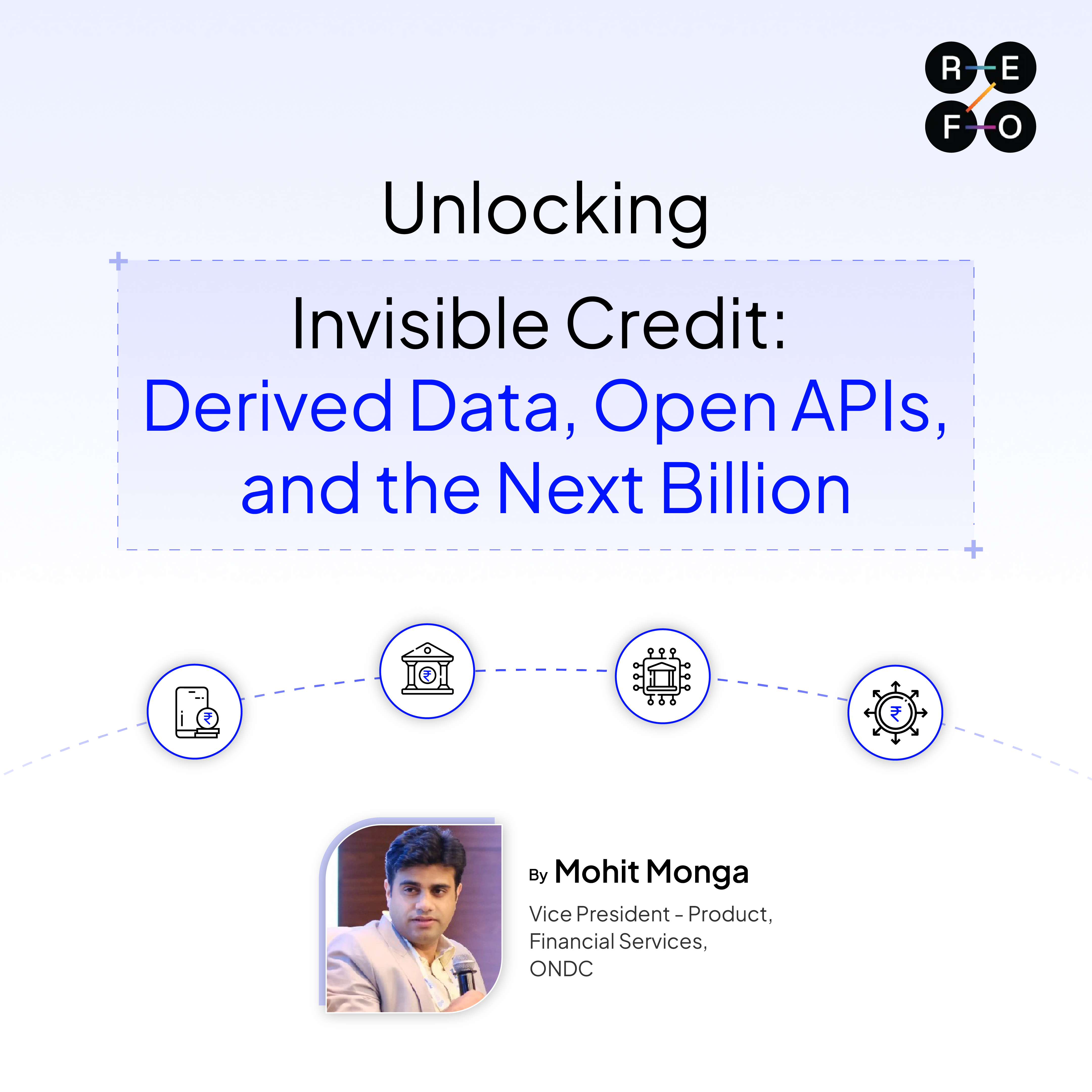Unlocking invisible credit : Derived data, Open APIs and The Next billion

By Mohit Monga, VP - Product - Financial Services, ONDC
The landscape of financial assessment undergoes a critical transformation. For decades, our definitions of creditworthiness have been inextricably linked to established financial histories – a framework that, while robust, increasingly overlooks the economic vitality of billions.
The challenge is immediate: Credit underwriting for unsecured loans primarily relies on a borrower's Credit Bureau history and bank statements. While this approach works well for individuals with stable incomes ( 10-15 Crore Indians), it falls short for a significant portion ( ~ 30-50Cr Indians ) of the Indian population—both individuals and businesses—with limited credit bureau records or inconsistent income patterns.
This dynamic presents a profound, yet largely untapped, market opportunity for the banking sector.
Redefining Risk: The Power of Alternative Data
The inherent constraints of traditional credit models are evident. They typically exclude "thin-file" or "no-file" individuals, create systemic inefficiencies, and perpetuate artificial ceilings on growth by focusing on already saturated segments. Adherence to these models constitutes a strategic vulnerability in a dynamic market. This approach is not about lowering standards, but about employing more intelligent and comprehensive means of assessment.
The solution is precision: A compelling approach lies in leveraging alternative data gathered through interactions with trusted platforms or based on lifestyle indicators. This data yields valuable insights into a customer's income potential and default risk.
Illustrative Use Cases & Underwriting Signals: The predictive power of alternative data is already manifesting across diverse segments:
- Gig Workers: Ride-hailing/delivery app transaction history provides insights into earnings consistency and peak-hour reliability.
- Small Farmers: Agri-tech IoT data (soil moisture, crop health) offers signals for harvest yields and associated earnings.
- D2C Sellers: E-commerce/logistics fulfillment rates reveal order volume stability and return rates.
- Urban SMEs: UPI/Bharat BillPay cash flows can indicate revenue seasonality and vendor payment patterns.
Despite this promise, two critical challenges persist in alternative data-based credit underwriting:
- Establishing trust and credibility in the reliability of these data sources, and
- Accurately determining their predictive power with minimal investment in model development and testing.
Our Blueprint for Foundational Innovation: The Innovation Sandbox
To systematically address these challenges and catalyze critical innovation, there is a clear and pressing need for an open-source sandbox or utility. This utility is designed to serve as a pivotal aggregator, seamlessly connecting various data providers and model developers. It will empower lenders to rigorously test and refine credit programs targeting specific customer segments (e.g., cab drivers) before orchestrating scaled deployment.
It is a robust blueprint conceived to effectively assess creditworthiness in populations previously considered opaque by traditional metrics.
Key Pillars of the Proposed Sandbox:
- Data Aggregation & Standardization:
- A Centralized Repository can house anonymized alternate datasets, encompassing gig platform earnings, agri-tech IoT data, and logistics fulfillment metrics.
- Synthetic Data Generation can facilitate low-cost experimentation prior to real-world deployment.
- Trust & Credibility Framework:
- Data Source Verification can certify providers (e.g., Uber for driver data, Ninjacart for farmer data).
- Robust Consent Management can ensure DPDP-compliant borrower permission for all data usage.
- Model Testing & Validation:
- The sandbox offers Pre-built ML Models (e.g., income prediction, default risk scoring) for rapid, efficient testing.
- Integrated Benchmarking Tools can allow direct comparison of alternate data models against traditional bureau-based underwriting, providing clear performance insights.
- Crucially, Bias Detection capabilities can be embedded to ensure fairness across gender, geography, and income levels.
- Low-Cost Experimentation:
- The platform can foster Collaborative Model Building, encouraging crowdsourced improvements from model providers, fintechs, researchers, and lenders.
- Regulatory & Risk Safeguards:
- For pre-deployment assurance, Simulated Loan Books and Backtesting functionalities can allow rigorous testing of default rates before live lending.
- It can facilitate proactive Regulator Engagement, enabling the sharing of findings with the RBI to shape policy collaboratively.
- Finally, Early Warning Systems can detect overfitting or model drift in real-time, ensuring continuous model integrity and risk management.
The Collaborative Horizon: Shaping Finance's Next Chapter
Embracing these advanced methodologies is not a speculative venture but a pragmatic, data-driven pathway to and sustainable growth. This evolution is an imperative for the continued relevance and societal impact of financial institutions in the 21st century.
The call to action is clear: Let us collaboratively shape a future where creditworthiness is assessed not by outdated proxies, but by a holistic, intelligent understanding of an individual's true financial potential. This transformation mandates:
- Investing in cutting-edge R&D for alternative data models.
- Fostering robust cross-industry collaboration for insights, while ensuring stringent data governance.
- Engaging proactively with regulatory bodies to forge an enabling and secure environment for this new frontier.
By embracing these innovations with bold foresight and a collective commitment to ethical practice, we stand on the precipice of not just expanding our balance sheets, but fundamentally redefining the very promise of financial inclusion, cultivating a more resilient, equitable, and prosperous global economy for generations to come. This is our shared mandate; this is our opportunity for enduring impact.